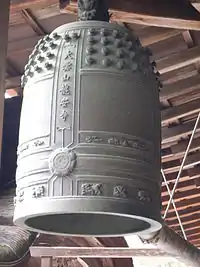
Bonshō are large bells found in Buddhist temples throughout Japan, used to summon the monks to prayer and to demarcate periods of time. Rather than containing a clapper, bonshō are struck from the outside, using either a hand-held mallet or a beam suspended on ropes. The bells are usually made from bronze, typically augmented and ornamented with bosses, raised bands, and inscriptions. The earliest appearance of these bells in Japan dates to around 600 CE, although the general design is of much earlier Chinese origin. Their penetrating and pervasive tone carries over considerable distances, which led to their use as signals, timekeepers, and alarms. The sound is thought to have supernatural properties; it is believed, for example, that it can be heard in the underworld. Their spiritual significance means that they play an important role in Buddhist ceremonies, particularly the New Year and Bon festivals. Throughout Japanese history a number of these bells have become associated with stories and legends, both fictional, such as the Benkei Bell of Mii-dera, and historical, such as the bell of Hōkō-ji. In modern times, bonshō have become symbols of world peace. (Full article...)